Introduction
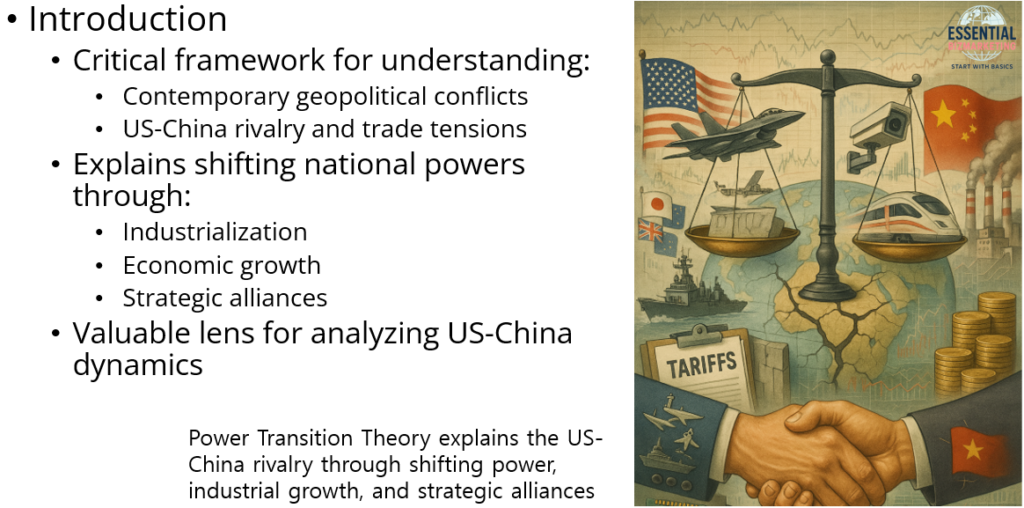
Understanding Power Transition Theory is crucial due to its effectiveness in explaining contemporary geopolitical conflicts, notably the US-China rivalry and the ongoing trade war. This theory provides a structured perspective on the dynamics of shifting national powers, emphasizing the role of industrialization, economic growth, and strategic alliances. Given its explanatory power concerning current tensions between the US and China, particularly under President Trump’s administration and its intensified tariff conflicts, it is essential to examine Power Transition Theory as a lens to better comprehend and navigate international politics (Tammen & Kugler, 2020).
Background
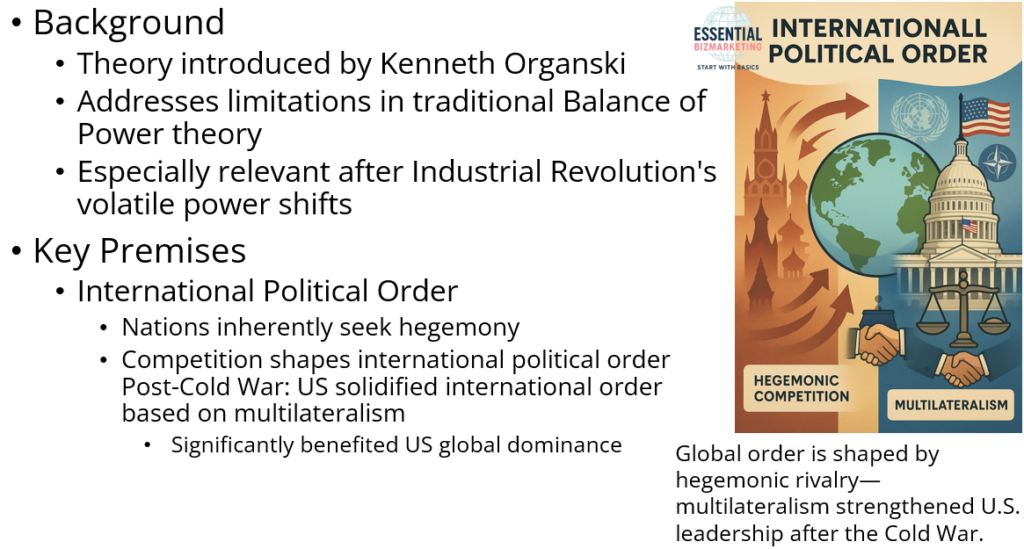
Power Transition Theory, introduced by Kenneth Organski, emerged as an important framework addressing limitations in traditional Balance of Power theory, particularly its inadequacy in explaining the volatile shifts in national power following the Industrial Revolution (Organski, 1958).
Key Premises
International Political Order
Nations inherently seek hegemony, and their competition shapes the international political order (Organski & Kugler, 1980). After the Cold War, the United States solidified its international order based on multilateralism, significantly benefiting its global dominance (Nye, 2015).
Shift in National Power
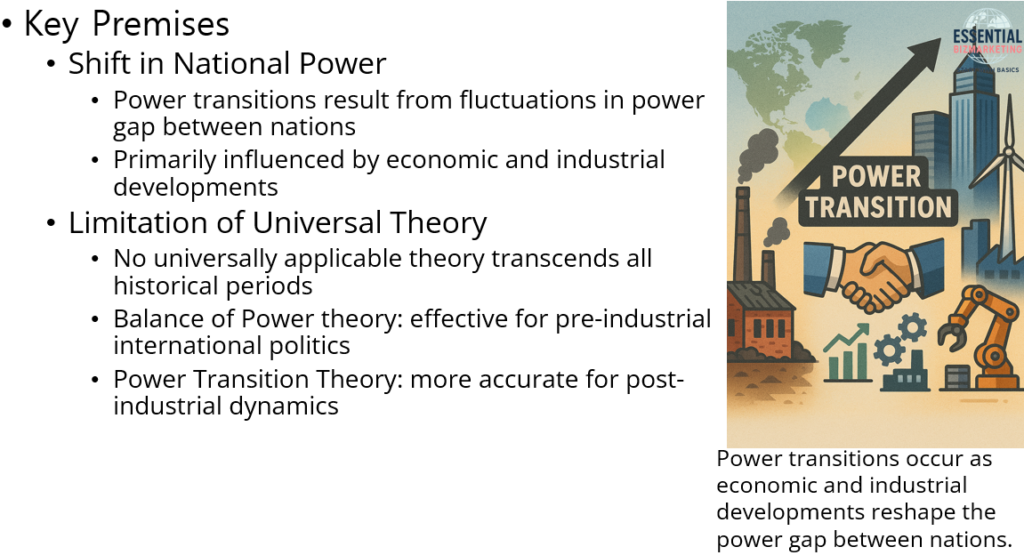
Power transitions result from fluctuations in the power gap between nations, influenced primarily by economic and industrial developments (Tammen et al., 2000).
Limitation of Universal Theory
Power Transition Theory asserts that there is no universally applicable theory transcending all historical periods. While Balance of Power theory effectively described pre-industrial international politics, Power Transition Theory more accurately captures post-industrial dynamics (Organski & Kugler, 1980).
Core Arguments of Power Transition Theory
Components of National Power
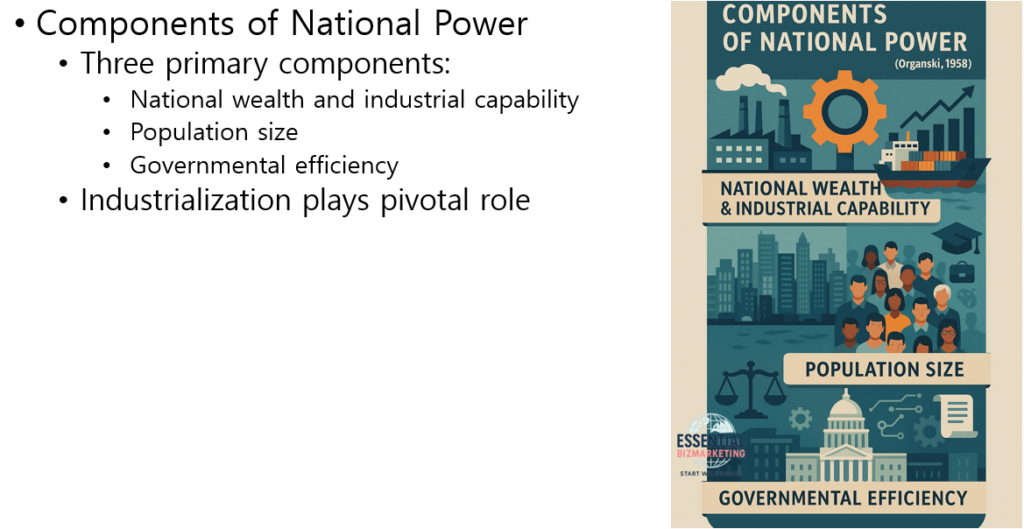
Organski identifies three primary components of national power: national wealth and industrial capability, population size, and governmental efficiency, with industrialization playing a pivotal role (Organski, 1958).
Phases of National Power Transition

- Potential National Power Phase: Characterized by a primarily agricultural economy, nations in this phase do not significantly change their power status without territorial expansion.
- Power Transition Phase: Nations develop their power internally through industrialization, altering their ranking in the global hierarchy without territorial aggression.
- Maturation of National Power: A future phase where national power stabilizes, though its specifics remain uncertain.
Structure of the International System

The global system is hierarchical, structured around national power, categorizing nations into dominant powers, major powers, minor powers, and dependencies. This hierarchy also delineates satisfied versus dissatisfied groups regarding the dominant power’s established order (Organski & Kugler, 1980).
Conditions for War and Peace

Conflict likelihood increases when dissatisfied nations industrialize and narrow the power gap with the dominant power, particularly when supported by other dissatisfied countries. Conversely, peace prevails when the dominant power maintains overwhelming military supremacy or when both dominant and challenging nations share similar political ideologies (e.g., the peaceful transition from the UK to the US post-WWII) (Levy, 2008).
Evolution of Power Transition Theory: Alliance Transition Theory

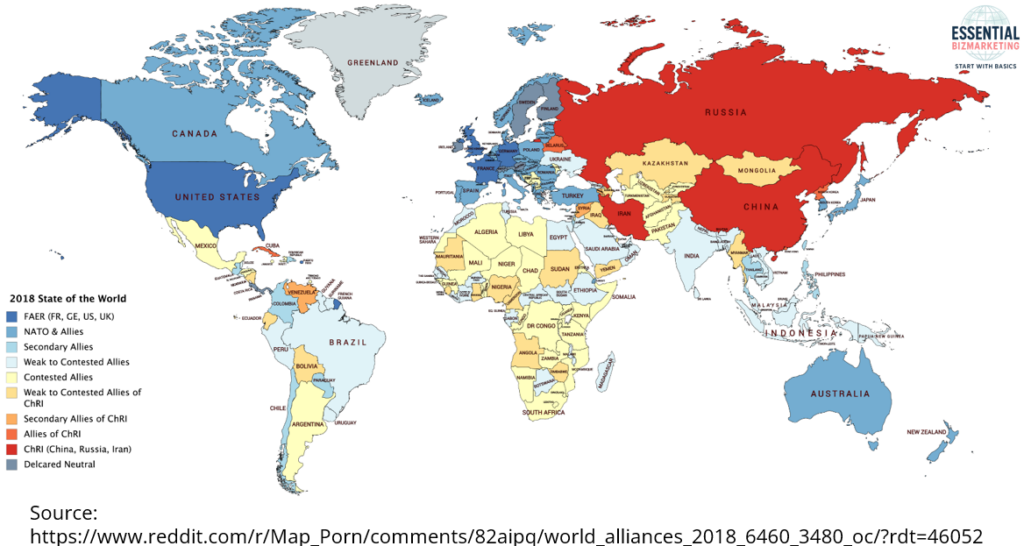
Alliance Transition Theory expands Organski’s concept, considering external alliances alongside internal industrialization as crucial to national power growth (Tammen et al., 2000).
US-China Rivalry: Application of Power Transition Theory
US Foreign Policy towards China

Historically, the US attempted to integrate China into its liberal international order through appeasement policies, exemplified by China’s WTO accession in 2001. However, China’s subsequent rise and advocacy for a socialist market economy challenged US dominance (Mearsheimer, 2014).
Strategic US Response
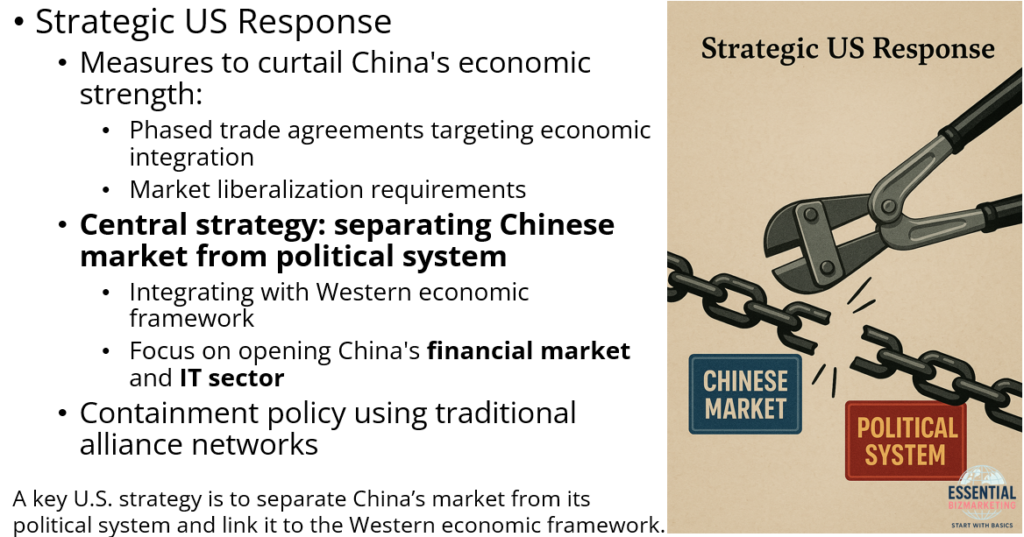
The US has adopted measures to curtail China’s economic strength, notably through phased trade agreements targeting China’s economic integration and market liberalization. A central aspect of this strategy involves separating the Chinese market from its political system and integrating it with the Western economic framework. Specifically, the opening of China’s financial market and IT sector is seen as a critical component.
These sectors are not only central to China’s economic development but also deeply embedded in the Communist Party’s mechanisms of control. By promoting liberalization in finance and information technology, the US aims to weaken state dominance and embed Western regulatory and commercial norms. Financial openness increases China’s dependence on global capital flows, while IT liberalization exposes it to external standards in data governance, cybersecurity, and intellectual property. Together, these pressures are designed to foster internal contradictions within China’s political economy and create strategic leverage for the US in managing long-term competition.
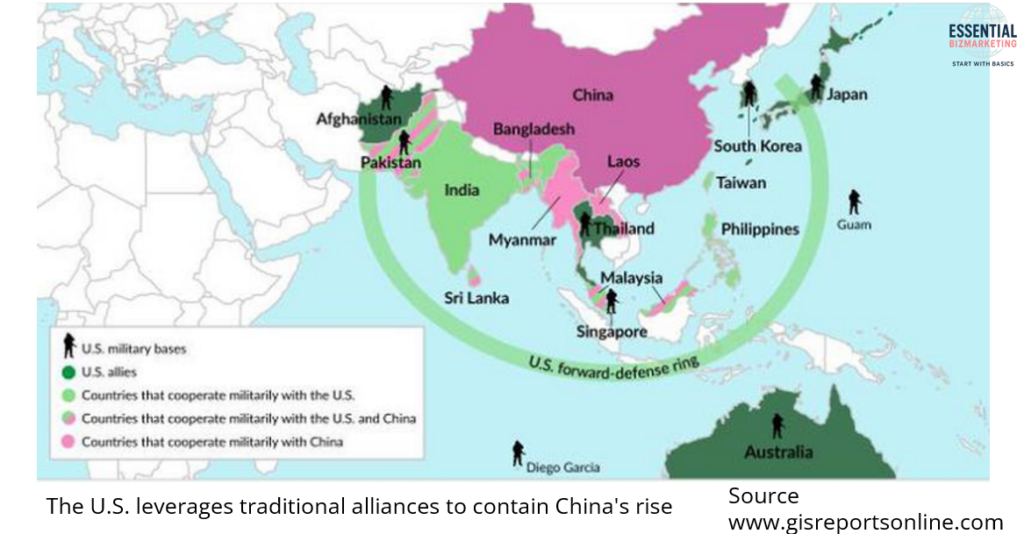
Additionally, the US employs a containment policy against China, utilizing alliances with traditional allies to resist China’s ascendancy (Allison, 2017).
Strategic Chinese Countermeasures

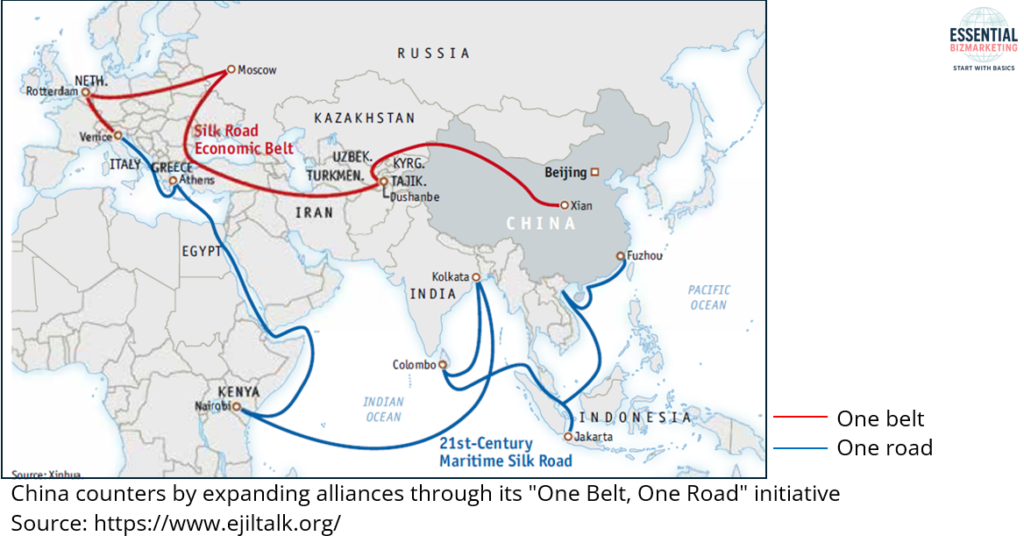
China counters by expanding alliances through its “One Belt, One Road” initiative, though it faces criticism for predatory economic practices and weak soft power (Hillman, 2020). China’s controversial pandemic response further diminished international trust (Economy, 2018).
Evaluating Current Policies: US and China
US Policy Evaluation
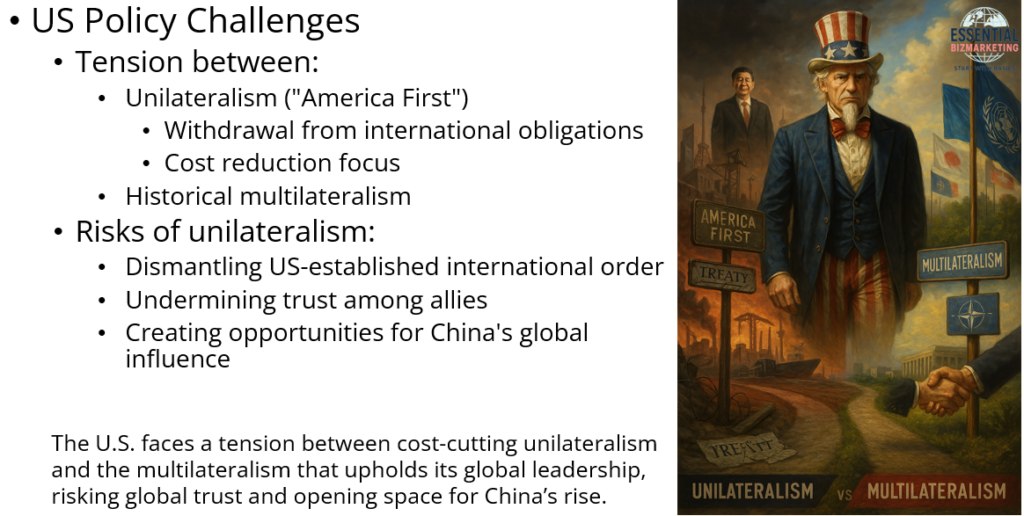
The United States currently faces a dual challenge between unilateralism (“America First” policy), marked by withdrawal from international obligations to reduce costs, and the multilateralism it historically championed. While unilateralism might temporarily reduce economic and political costs, it risks dismantling the foundations of the US-established international order, potentially undermining trust and legitimacy among allies and creating opportunities for China to assert greater global influence (Zakaria, 2020).
Chinese Policy Evaluation
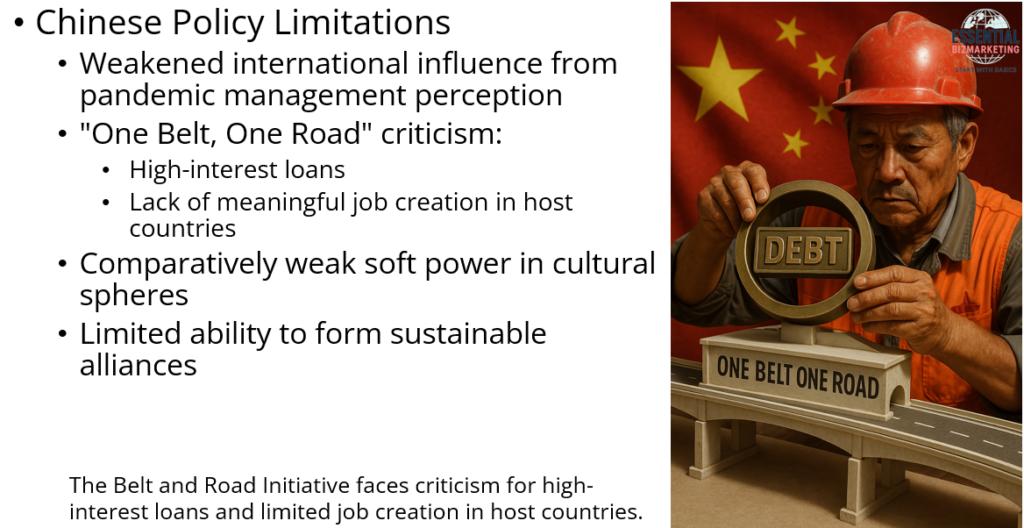
China’s international influence has been weakened by perceived irresponsible management of the COVID-19 pandemic, increasing global mistrust and antipathy. Furthermore, the implementation of the “One Belt, One Road” initiative has been criticized for predatory practices such as high-interest loans and lack of meaningful job creation in host countries. These factors, coupled with China’s comparatively weaker soft power in cultural and artistic spheres, limit its ability to form sustainable alliances (Hillman, 2020).
Future Implications
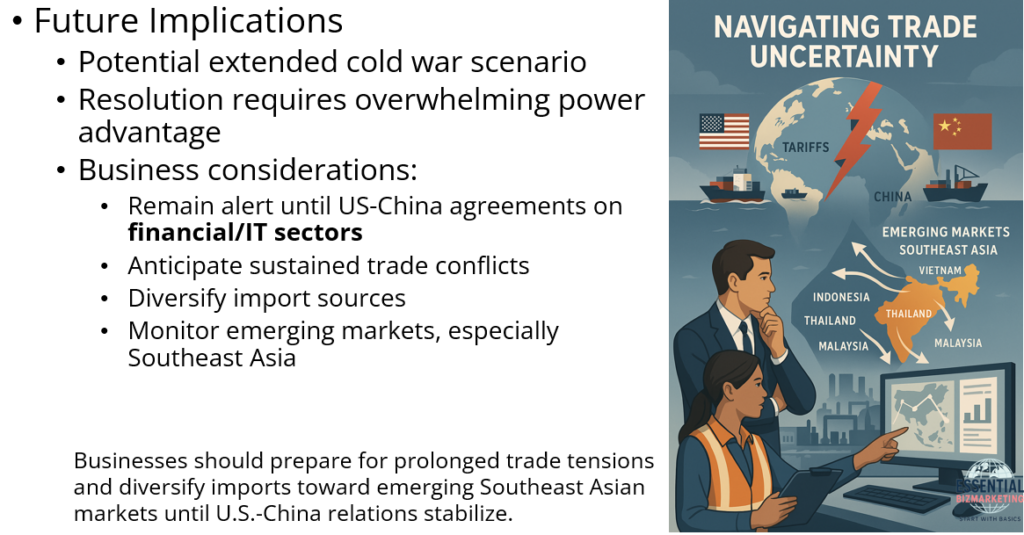
The ongoing US-China rivalry may manifest as an extended cold war scenario unless decisively resolved through overwhelming power. Businesses should remain alert until the US and China reach definitive agreements on China’s financial and IT sectors, as these agreements are crucial elements of US strategies aimed at curtailing China’s economic strength and influencing its market liberalization (Allison, 2017). Thus, businesses must anticipate sustained trade conflicts and diversify import sources, paying close attention to emerging markets, particularly in Southeast Asia, until US-China economic negotiations stabilize (Zakaria, 2020).
Conclusion
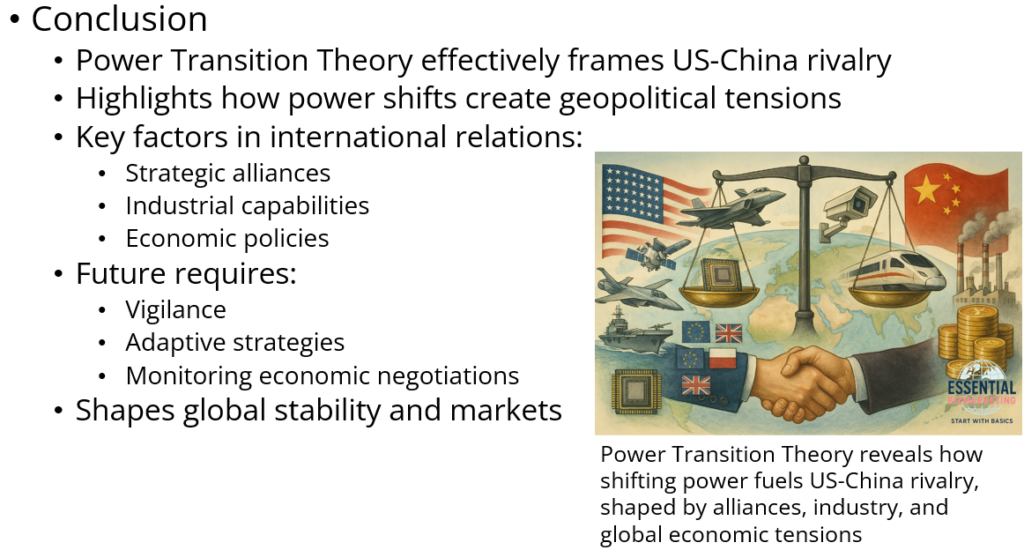
Power Transition Theory effectively frames the ongoing US-China rivalry, illustrating how shifts in national power can precipitate major geopolitical tensions. The theory underscores the significance of strategic alliances, industrial capabilities, and economic policies in shaping international relations. Continued vigilance and adaptive strategies will be essential as the US-China competition evolves, particularly within the context of economic negotiations and potential conflicts, shaping future global stability and market dynamics.
📚 References
Allison, G. (2017). Destined for War: Can America and China Escape Thucydides’s Trap? Houghton Mifflin Harcourt.
Hillman, J. (2020). The Emperor’s New Road: China and the Project of the Century. Yale University Press.
Levy, J. S. (2008). Power transition theory and the rise of China. In R. S. Ross & Z. Feng (Eds.), China’s ascent: Power, security, and the future of international politics (pp. 11–33). Cornell University Press.
Mearsheimer, J. J. (2014). “Can China Rise Peacefully?” The National Interest, 131, 23-37.
Nye, J. S. (2015). Is the American Century Over? Polity Press.
Organski, A. F. K. (1958). World Politics. Knopf.
Organski, A. F. K., & Kugler, J. (1980). The War Ledger. University of Chicago Press.
Tammen, R. L., & Kugler, J. (2020). The Rise of China and the Changing Global Order. Palgrave Macmillan.
Tammen, R. L., Kugler, J., Lemke, D., Stam, A., Abdollahian, M., Alsharabati, C., … & Organski, A. F. K. (2000). Power Transitions: Strategies for the 21st Century. CQ Press.
Zakaria, F. (2020). Ten Lessons for a Post-Pandemic World. W. W. Norton & Company.
📁 Start exploring the Blog
📘 Or learn more About this site
🧵 Or follow along on X (Twitter)
🔎 Looking for sharp perspectives on global trade and markets?
I recommend @GONOGO_Korea as a resource I trust and regularly learn from.
